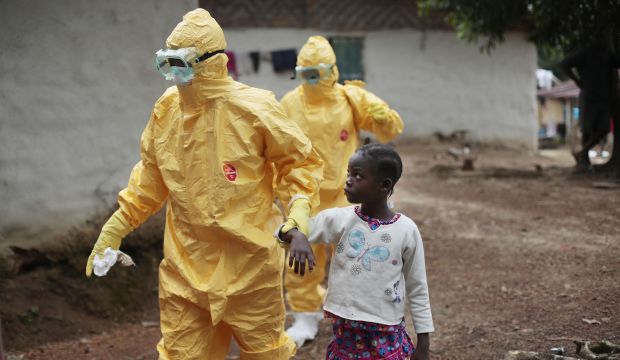
Nowa Paye, 9, is taken to an ambulance after showing signs of the Ebola infection in the village of Freeman Reserve, about 30 miles north of Monrovia, Liberia, on September 30, 2014. (AP Photo/Jerome Delay)
In the worst-hit states of Liberia, Sierra Leone and Guinea, Ebola is ravaging their food-producing ‘breadbasket’ regions, preventing planting and harvesting, and disrupting supply routes and markets.
“Hunger will kill us where Ebola failed,” said Pa Sorie, a 61-year-old rice and cassava farmer in Port Loko in northern Sierra Leone. A father of six with four grandchildren, he says he has already lost three close relatives to Ebola.
The UN’s World Food Programme and Food and Agriculture Organisation say border and market closures, quarantines and movement restrictions, and widespread fear of Ebola have led to food scarcity, panic buying and price increases, especially in Sierra Leone and Liberia.
Since it was first reported in the forest region of Guinea in March, the hemorrhagic fever has killed 3,338 people.
It crossed into Liberia and Sierra Leone and has triggered smaller outbreaks and cases in Nigeria, Senegal and even the United States, prompting the World Health Organization to declare an international public health emergency on August 8.
As governments from the United States to China and Cuba send troops and medics to the affected corner of Africa in an attempt to contain the epidemic, relief agencies are scrambling to ward off the humanitarian crisis threatening hundreds of thousands along with the health disaster.
“The country will starve,” warned Mary Hawa John-Sao, vice president of Sierra Leone’s National Farmers’ Federation and an award-winning grower. Her own fields were lying unattended and spoiling in quarantined Kailahun district, which along with neighboring Kenema in the east and Port Loko and Bombali in the north are the country’s traditional food-growing areas.
John-Sao, 55, said 75 percent of those killed by Ebola in Kailahun and Kenema were farmers and hunger was “imminent.”
The World Food Programme is trying to provide food to around 1 million people in the three worst-affected countries. As of September 14, it had distributed 3,300 tonnes of food to more than 180,000 people in the three nations in a race against hunger.
Sierra Leone Agriculture Minister Sam Sesay said entire farming communities in some parts of his country had been wiped out by Ebola, with farms abandoned and crops left rotting.
His Liberian counterpart, Florence Chenoweth, describes a similar situation in her country’s rural Lofa county.
UN officials have heeded the warning, saying governments must focus not just on containing Ebola but also on the social and developmental damage the disease is inflicting on some of the world’s poorest states, still recovering from civil wars.
“The fertile fields of Lofa County, once Liberia’s breadbasket, are now fallow. In that county alone, nearly 170 farmers and their family members have died from Ebola,” WHO Director General Margaret Chan told the UN Security Council last month.
Ironically, the measures the Sierra Leone and Liberian governments have taken to try to halt the spread of Ebola, which is passed on by contact with the bodily fluids of infected persons, have worsened the disruption to farming.
Both countries placed military-enforced quarantines on their worst-affected rural areas, restricting movement in and out.
Five of Sierra Leone’s 14 districts are currently quarantined and the government last month shut down the entire country for three days, restricting all movements in a bid to staunch the relentless pace of Ebola infection.
Ahmed Nanoh, head of Sierra Leone’s agribusiness chamber, urged the government to loosen the quarantines because they prevented farmers from reaching outlying fields to till and harvest staple crops of rice, cassava, maize and millet.
“Farmers who used to cultivate 10 hectares (25 acres) can no longer cultivate even two hectares due to the impact of Ebola,” Nanoh said.
About 65 percent of Sierra Leone’s 6 million people depend on agriculture, which represents about 40 percent of the national economy, so the Ebola emergency and its impact on farming are already dragging down overall economic growth.
The finance ministry said a whole planting season could be lost. Growth this year is expected to slow to 8 percent from over 11 percent forecast earlier in the year and inflation is expected to climb to 10 percent by the year-end from 7.5 percent as food prices continue to climb because of shortages.
Liberia could experience an even worse decline, with the IMF forecasting a fall in GDP to 2.1 percent from 6 percent projected earlier. Inflation is expected to hit 13 percent at the end of the year, compared with 7.7 percent earlier.
The Ebola impact is wrecking rural farming areas in Liberia and Sierra Leone which are still recuperating from the civil wars of the 1990s that also drove farmers from the fields and devastated rural communities.
Liberia’s Commerce Minister, Axel Addy, said the government was negotiating with importers to try to ensure the country had three months’ supply of rice. About 6 million tonnes of rice is consumed every year. But importers were also complaining of rising costs because insurance premiums on vessels bringing cargo to Liberian ports had increased due to fears of Ebola.
And for many, the food aid may not arrive in time to stave off shortages that are growing by the day.
Dah Leleah, a member of a rice cooperative and father of seven in Liberia’s Nimba county, told Reuters he was trying to supplement his family’s dwindling diet by catching fish.
“We are now eating the cassava we planted,” he said. “There is no way we can work on our farms.”

Trackbacks/Pingbacks